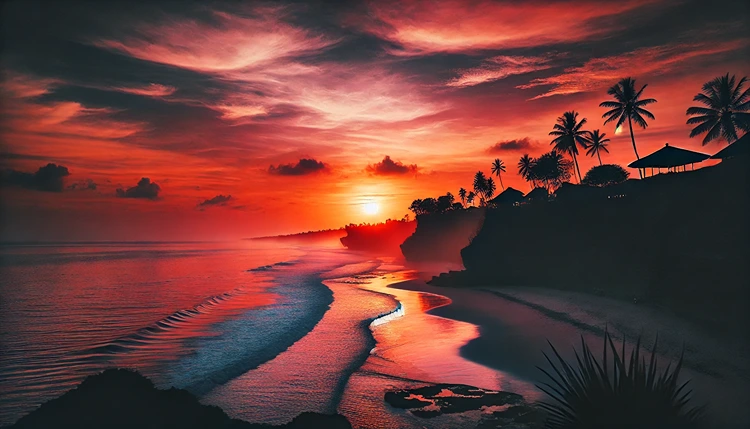Bali is famous for its stunning beaches, but planning the perfect trip isn’t just about picking a random date on the calendar. The best times to visit Bali’s beaches can greatly impact your overall experience, whether you’re chasing the surf, looking for serene sunbathing spots, or hoping to avoid the peak tourist season. Let’s dive into why timing your visit matters and what you should consider before booking that flight.
The climate in Bali can shift between tropical sunny days and heavy rainfall depending on the season. Understanding these weather patterns, along with tourist crowds, helps you make the most of your beach trip. Knowing the best months to visit allows you to plan your activities, like surfing, snorkeling, or simply lounging in the sand, without any unwanted surprises.
When Is the Best Weather in Bali?
Most travelers search for the ideal beach weather when planning a trip to Bali. The island has two main seasons: the dry season and the wet season. The dry season is widely considered the best time to hit the beaches. But let’s break this down a bit more to see why this is the best option.
Dry Season (April to October): Perfect for Sun-Seekers
If you’re a fan of endless sunshine and mild humidity, Bali’s dry season is when you’ll want to pack your bags. From April to October, the island enjoys consistent weather with warm temperatures and minimal rain. The beaches are ideal for sunbathing, surfing, and other outdoor activities. This period also boasts calmer seas, making it the perfect time for swimming and diving.
Helpful Hint:
Planning to visit during the dry season? Be sure to book your accommodations early, especially if you’re aiming for the peak months of July and August. These are the busiest times for tourism, and the best beach resorts fill up fast.
Wet Season (November to March): A Gamble with Rain
The wet season in Bali lasts from November to March, bringing heavy rain and high humidity. While you can still enjoy sunny days, the unpredictable weather can dampen your beach plans. Some outdoor activities like surfing can still be enjoyed, but beach lounging or long walks on the shore might be less appealing.
Stats:
Did you know that Bali’s wet season can bring as much as 300mm of rain in a single month? If you’re planning a visit during these months, be prepared for downpours, especially in January and February.
When Are the Best Times for Surfing in Bali?
For those chasing the waves, Bali is a year-round surfing destination, but the best times depend on where you plan to hit the water. Different beaches are optimal at different times, so it’s worth knowing what to expect before you go.
Dry Season: Western Coast for the Best Waves
During the dry season, the western coast of Bali, including popular beaches like Kuta, Uluwatu, and Canggu, offers some of the best surfing conditions. The swells are perfect, and the winds are offshore, making it a dream for surfers of all levels.
- Kuta Beach: Great for beginners with its soft, rolling waves.
- Uluwatu: A hotspot for advanced surfers chasing big swells.
- Canggu: Ideal for intermediate surfers looking for a balance between fun waves and fewer crowds.
Wet Season: Eastern Coast for Consistent Surf
Don’t worry if your trip falls during Bali’s wet season. The eastern coast, particularly beaches like Nusa Dua and Keramas, still offer great surfing during this period. The winds switch to be offshore here, providing clean, consistent waves, even during the rainy months.
Helpful Hint:
If you’re planning to surf during the wet season, keep in mind that beaches on Bali’s eastern coast will be less crowded, and accommodation prices are often lower.
Best Months for Snorkeling and Diving in Bali
Bali is home to some of the world’s most vibrant marine life, making it a prime destination for snorkeling and diving enthusiasts. However, your timing plays a crucial role in the quality of your underwater experience.
April to October: Crystal Clear Waters
The dry season is hands-down the best time for snorkeling and diving in Bali. The water visibility is at its clearest, and the calm seas make it easy to explore the coral reefs and marine life around popular spots like Menjangan Island, Nusa Penida, and Amed.
Snorkelers and divers will appreciate the warm water temperatures, which hover around 27-30°C, providing optimal conditions for both casual underwater explorations and more advanced dives.
November to March: Less Visibility, But Still Worth It
While the wet season brings more rain, there are still opportunities for snorkeling and diving, especially in areas less affected by the rain, like Nusa Lembongan. However, water visibility might be reduced due to runoff from the land, so it’s not the ideal season for underwater activities.
Stats:
On average, water visibility during the dry season in Bali can reach up to 30 meters in prime dive spots like Menjangan Island. This drops significantly during the wet season, sometimes down to 10-15 meters.
When Are the Crowds in Bali the Heaviest?
Timing your Bali beach trip to avoid the heavy tourist crowds is crucial if you want a peaceful experience. Depending on the month, you might find yourself surrounded by fellow sun-seekers or enjoy a relatively empty coastline. Let’s break down when Bali gets the most crowded, and when you can expect a more relaxed atmosphere on the beaches.
July to August: Peak Tourist Season
July and August are considered the peak tourist months in Bali, with travelers from around the world flocking to the island during the height of the dry season. This is when the weather is at its best, but it also means that popular beaches like Seminyak, Kuta, and Jimbaran are packed with visitors. If you plan on traveling during this time, expect higher prices for accommodation and activities.
Helpful Hint:
If you’re visiting Bali in July or August, try exploring lesser-known beaches like Balangan or Padang Padang. These spots tend to be quieter, offering a more peaceful escape from the crowded main tourist areas.
April to June & September to October: Shoulder Season Sweet Spot
If you want to experience the best of Bali’s beaches without the massive tourist crowds, aim for the shoulder seasons of April to June and September to October. The weather is still fantastic, and you’ll have more space to enjoy the beaches. Accommodation and activity prices also tend to drop during these months, giving you better value for your money.
- April to June: Fewer crowds and pleasant beach weather.
- September to October: Still warm and sunny, but with significantly reduced tourist numbers.
November to March: Low Season, Fewer Crowds
Bali’s wet season from November to March is considered the low season for tourism. While the rainy weather can deter some visitors, this is also the time to enjoy quieter beaches. If you don’t mind the occasional downpour and are looking for a more peaceful beach getaway, visiting Bali during this period can be a relaxing and budget-friendly option.
When to Visit Bali for Beach Festivals and Events
Bali hosts a variety of festivals and events throughout the year, many of which are centered around the island’s vibrant beach culture. Whether you’re interested in attending a local festival or a major surfing competition, knowing when these events take place can help you plan a more immersive experience during your beach trip.
June: Bali Arts Festival
Every June, the Bali Arts Festival takes place, celebrating the island’s rich cultural heritage through performances, exhibitions, and traditional dances. While not strictly a beach event, it’s a unique opportunity to experience Bali’s cultural side during your beach trip. Combining beach days with festival visits can give you the best of both worlds.
July: Uluwatu Surf Festival
Surf enthusiasts flock to Bali in July for the Uluwatu Surf Festival. Held at the famous Uluwatu Beach, this event brings together surfers from around the globe to compete and celebrate the island’s surf culture. If you’re a surfing fan, visiting during this time allows you to catch some incredible action on the waves while soaking in the beach vibe.
What Is the Best Time to Avoid Mosquitoes and Tropical Bugs in Bali?
While Bali is undoubtedly beautiful, it’s still a tropical island, and that means dealing with tropical bugs, including mosquitoes. Some months are worse than others, and timing your trip to avoid the peak mosquito season can make your beach experience much more comfortable.
Dry Season: Fewer Bugs, More Comfort
One of the benefits of visiting during the dry season (April to October) is that there are generally fewer mosquitoes due to the lack of rain. The dry conditions mean less stagnant water, which is where mosquitoes breed. If you’re someone who attracts bugs easily, plan your trip during these months to minimize the annoyance of mosquitoes.
Wet Season: Be Prepared for Mosquitoes
The wet season (November to March) brings not only rain but also an increase in mosquito activity. If you’re visiting Bali during this time, make sure to pack insect repellent and stay in accommodations with mosquito nets or screens. The beaches can still be enjoyable, but you’ll need to take extra precautions to avoid bites, especially in the evening.
Best Time to Enjoy Bali’s Famous Sunsets

No trip to Bali is complete without witnessing one of the island’s legendary sunsets. The timing of your visit can affect how breathtaking these sunsets are, as different seasons offer varying levels of visibility and atmospheric conditions.
July to August: Clear Skies for Spectacular Sunsets
If watching a jaw-dropping sunset from a beach like Tanah Lot or Uluwatu is high on your list, then visiting Bali during the dry season is your best bet. July and August provide clear skies with minimal cloud cover, allowing the sun to set over the ocean in a spectacular display of colors. These months are perfect for evening beach visits and romantic sunset views.
April to June: Beautiful Evening Views Without the Crowds
For a more peaceful sunset experience, April to June offers the same stunning evening views without the peak tourist crowds. You’ll still get the gorgeous reds and oranges of a Bali sunset, but with more space to enjoy it from your chosen beach spot.
Helpful Hint:
For the best sunset views, head to Uluwatu Beach or Tanah Lot. Both spots offer a clear view of the sun dipping below the horizon, with the added beauty of Bali’s dramatic cliffs in the background.
Best Time to Visit Bali’s Beaches by Activity
Best Months for Beach Activities in Bali
| Activity | Best Time | Weather Conditions |
|---|---|---|
| Surfing (West Coast) | April to October | Consistent swells, dry weather, and offshore winds |
| Snorkeling/Diving | April to October | Clear waters, calm seas, and great visibility |
| Sunset Watching | July to August | Clear skies, perfect evening conditions |
| Beach Festivals | June to July | Dry weather, warm temperatures |
| Budget Travel | November to March | Wet season, fewer tourists, lower prices |
How Does Bali’s Cultural Calendar Affect Your Beach Experience?
Bali’s rich cultural traditions play a big role in shaping the beach experience, especially if your visit coincides with a local holiday or celebration. While most cultural events don’t directly affect beach access, certain occasions can alter the vibe of the island or lead to closures of certain areas.
Nyepi (March): A Day of Silence and Beach Closures
One of the most significant holidays in Bali is Nyepi, the Balinese Day of Silence, which usually falls in March. On this day, the entire island shuts down, including beaches. It’s a time of reflection for the locals, and tourists are also expected to respect the quiet, staying inside their accommodations. If you’re planning to visit Bali in March, be aware of this cultural day and plan accordingly, as you won’t be able to enjoy the beaches on Nyepi.
Galungan (Twice a Year): A Vibrant Cultural Experience
Galungan is another important Balinese celebration that occurs twice a year. While it doesn’t result in beach closures, you might find the island busier with local festivities. It’s a fantastic time to visit if you want to combine a beach trip with a deeper cultural experience, as you’ll witness traditional dances, offerings, and vibrant street decorations.
Best Time for Beachfront Dining in Bali
One of the highlights of any beach trip is enjoying a meal with a view, and Bali offers countless beachfront dining experiences. Whether you’re indulging in fresh seafood or sipping on a cocktail, knowing when to visit can enhance your dining experience.
Dry Season: Optimal Outdoor Dining
The dry season, from April to October, is the best time to enjoy al fresco dining at Bali’s beachfront restaurants. The pleasant weather, mild breezes, and clear skies create the perfect ambiance for an evening meal by the ocean. Popular dining spots like Jimbaran Bay are especially stunning during these months, offering incredible sunset views as you dine on fresh grilled seafood.
Wet Season: Indoor Options Available
While the wet season brings more rain, many of Bali’s beachfront restaurants are equipped with covered seating, allowing you to still enjoy the ocean views without getting drenched. However, sudden downpours may interrupt your dining experience if you’re sitting outdoors, so it’s worth checking the forecast before making any reservations.
How Bali’s Monsoon Affects Beach Cleanliness
Bali’s beaches are world-famous, but their cleanliness can vary depending on the season. During certain months, the combination of tides and rainfall can affect the condition of the shoreline. Understanding how Bali’s monsoon season impacts beach cleanliness can help you plan your trip around the best times to enjoy pristine beaches.
Wet Season: Be Prepared for Debris
During Bali’s wet season, especially between December and February, monsoon rains can wash debris and trash onto the beaches. Popular spots like Kuta and Seminyak are particularly affected, as their currents tend to collect the runoff. While efforts are made to clean the beaches regularly, the influx of debris can be disheartening for beachgoers during these months.
Helpful Hint:
If you’re visiting during the wet season and want to avoid littered beaches, try heading to less popular beaches like Padang Bai or Amed. These spots are usually cleaner, even during the rainy months.
Dry Season: Cleaner, More Pristine Beaches
In contrast, Bali’s dry season brings significantly cleaner beaches. With little rain to wash debris into the sea, the shores remain mostly pristine, especially in popular areas like Nusa Dua and Jimbaran. If beach cleanliness is a top priority for you, plan your visit between April and October for the best experience.
What to Pack for a Bali Beach Trip Based on the Season
Packing for a Bali beach vacation isn’t just about swimsuits and sunscreen. What you bring can vary greatly depending on when you visit. Let’s look at what you’ll need for both the dry and wet seasons to ensure you’re prepared for anything Bali’s weather throws at you.
Dry Season Essentials
- Light clothing: Think breathable fabrics like cotton and linen to stay cool in the tropical heat.
- Sunscreen: The sun is intense during the dry season, so high-SPF sunscreen is a must.
- Swimwear: With calm seas and sunny days, you’ll want to spend most of your time in the water.
- Water shoes: For snorkeling or exploring rocky beaches, these are a good idea to protect your feet.
Wet Season Essentials
- Waterproof clothing: Pack a lightweight rain jacket for sudden downpours.
- Insect repellent: Mosquitoes are more active during the wet season, so this is essential.
- Umbrella: A small, portable umbrella is handy for beach strolls in case of rain.
- Flip-flops or sandals: Make sure your footwear is easy to dry, as the rain can come and go unexpectedly.
Pros and Cons of Visiting Bali’s Beaches Throughout the Year
Pros
- Dry season offers consistent sunny weather, perfect for beach activities.
- Peak surf conditions on the western coast during the dry season.
- Fewer mosquitoes and tropical bugs from April to October.
- Clear water visibility for snorkeling and diving during dry months.
- Shoulder seasons (April-June, September-October) have great weather with fewer tourists.
Cons
- Peak tourist season (July-August) results in crowded beaches and higher prices.
- Wet season brings unpredictable rain and rougher seas.
- More debris washes ashore during the wet season.
- Higher mosquito activity during the wet months of November to March.
- Popular beach locations may feel overly commercialized in peak months.
FAQs
Final Words
Timing your Bali beach trip is essential for getting the most out of the island’s natural beauty and avoiding potential pitfalls like heavy rain or crowded shores. By planning your visit during the dry season, you’ll enjoy sunny days, pristine beaches, and the best conditions for outdoor activities like surfing, snorkeling, and diving. While the wet season offers a quieter and more budget-friendly experience, it also comes with increased rain and debris on certain beaches. Ultimately, whether you’re seeking the perfect wave, a peaceful spot to relax, or vibrant beachside dining, knowing when to visit Bali’s beaches will ensure a memorable experience.
By considering the seasons, tourist patterns, and Bali’s unique cultural events, you can tailor your trip for a beach getaway that fits your preferences and expectations. Make sure to pack accordingly and be mindful of local customs like Nyepi, so you can fully enjoy Bali’s sun, surf, and sand.









